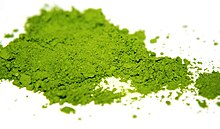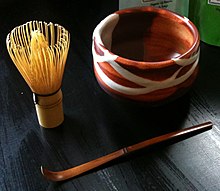Matcha: Difference between revisions
Yuanchosaan (talk | contribs) m better without the thumbnail, I think |
|||
| Line 3: | Line 3: | ||
| Tea_type = [[Green tea|Green]] |
| Tea_type = [[Green tea|Green]] |
||
| Tea_color = Green |
| Tea_color = Green |
||
| Tea_image = [[File:Matcha tea.jpg |
| Tea_image = [[File:Matcha tea.jpg|Matcha Tea|220px]] |
||
| Tea_origin = [[Japan]]<!--Japan=production, not China=history--> |
| Tea_origin = [[Japan]]<!--Japan=production, not China=history--> |
||
| Tea_names = [[wikt:抹茶|抹茶]], "fine powder tea" |
| Tea_names = [[wikt:抹茶|抹茶]], "fine powder tea" |
||
Revision as of 06:19, 22 August 2011
| Matcha | |
|---|---|
 | |
| Type | Green |
| Other names | 抹茶, "fine powder tea" |
| Origin | Japan |
| Quick description | Stone ground Japanese green tea |
Matcha (抹茶, pronounced [mat.tɕa][1]) refers to finely-milled green tea, most popular in Japan. The cultural activity called the Japanese tea ceremony centers on the preparation, serving, and drinking of matcha. In modern times, matcha has also come to be used to flavour and dye foods such as mochi and soba noodles, green tea ice cream and a variety of wagashi (Japanese confectionery). Matcha is a fine ground, powdered, high quality green tea and not the same as tea powder or green tea powder.
Blends of matcha are given poetic names called chamei ("tea names") either by the producing plantation, shop or creator of the blend, or by the grand master of a particular tea tradition. When a blend is named by the grand master of some tea ceremony lineage, it becomes known as the master's konomi, or favoured blend.
History
In Tang Dynasty China (618-907), tea leaves were steamed and formed into tea bricks for storage and trade. The tea was prepared by roasting and pulverizing the tea, and decocting the resulting tea powder in hot water, adding salt.[2] In the Song Dynasty (960-1279), the method of making powdered tea from steam-prepared dried tea leaves, and preparing the beverage by whipping the tea powder and hot water together in a bowl became popular.[3] Preparation and consumption of powdered tea was formed into a ritual by Zen (Chan) Buddhists. The earliest Chan monastic code in existence, entitled Chanyuan qinggui (禪苑清規, Rules of Purity for the Chan Monastery, 1103), describes in detail the etiquette for tea ceremonies.[4][5]

Zen Buddhism and, along with it, the Chinese methods of preparing powdered tea were brought to Japan in 1191 by the monk Eisai. Powdered tea was slowly forgotten in China, but in Japan it continued to be an important item at Zen monasteries, and became highly appreciated by others in the upper echelons of society during the 14th through 16th centuries. Along with this development, tea plantation owners in Uji perfected techniques for producing excellent tea for matcha.
Production
Matcha is made from shade-grown tea leaves also used to make gyokuro. The preparation of matcha starts several weeks before harvest, when the tea bushes are covered to prevent direct sunlight. This slows down growth, turns the leaves a darker shade of green and causes the production of amino acids that make the resulting tea sweeter. Only the finest tea buds are hand picked. After harvesting, if the leaves are rolled out before drying as usual, the result will be gyokuro (jade dew) tea. However, if the leaves are laid out flat to dry, they will crumble somewhat and become known as tencha (碾茶). Tencha can then be de-veined, de-stemmed, and stone ground to the fine, bright green, talc-like powder known as matcha.[6]
It can take up to one hour to grind 30 grams of matcha.
Note that only ground tencha qualifies as matcha, and other powdered green teas, such as powdered sencha, are known as konacha (粉茶, lit. "powder tea").
The flavour of matcha is dominated by its amino acids. The highest grades of matcha have more intense sweetness and deeper flavour than the standard or coarser grades of tea harvested later in the year.
The most famous matcha-producing regions are Uji in Kyoto, Nishio in Aichi, Shizuoka, and northern Kyūshū.
Grades
Matcha is generally expensive compared to other forms of tea, although its price depends on its quality. Grades of matcha are defined by many factors.
Location on the tea bush
Where leaves destined for tencha are picked on the tea (Camellia sinensis) bush is vital.
The very top would have developing leaves that are soft and supple. This gives a finer texture to higher grades. More developed leaves are harder, giving lower grades a sandy texture. The better flavour is a result of the plant sending all its nutrients to the growing leaves.
Treatment before processing
Tencha leaves are traditionally dried outside in the shade and are never exposed to direct sunlight. However, these days, drying has mostly moved indoors. Quality matcha is vibrantly green also as a result of this treatment.
Stone grinding
Stone grinding is an art form in and of itself. Without the right equipment and technique, matcha can become "burnt" and suffer degraded quality.
Oxidation
Oxidation is also a factor in determining grade. Matcha exposed to oxygen can easily become compromised. Oxidized matcha has a distinctive hay-like smell and a dull brownish green colour.
Traditional preparation of matcha

There are two main ways of preparing matcha: thick (濃茶, koicha) and thin (薄茶, usucha).
Prior to use, the matcha is often forced through a sieve in order to break up clumps. There are special sieves available for this purpose, which are usually stainless steel and combine a fine wire mesh sieve and a temporary storage container. A special wooden spatula is used to force the tea through the sieve, or a small, smooth stone may be placed on top of the sieve and the device shaken gently.
If the sieved matcha is to be served at a Japanese tea ceremony, then it will be placed into a small tea caddy known as a chaki. Otherwise, it can be scooped directly from the sieve into a tea bowl.
A small amount of matcha is placed into the bowl, traditionally using a bamboo scoop called a chashaku, then a modicum of hot (not boiling, about 80 °C or 176 °F) water is added. The mixture is then whisked to a uniform consistency, using a bamboo whisk known as a chasen. There must be no lumps left in the liquid, and no ground tea should remain on the sides of the bowl. Because matcha can be bitter, it is traditionally served with a small wagashi sweet[7] (intended to be consumed before drinking), and without added milk or sugar. It is usually considered that 40 g of matcha will provide for 20 bowls of usucha or 10 bowls of koicha:[8]
Usucha, or thin tea, is prepared with approximately 1.75 grams[9] (amounting to 1.5 heaping chashaku scoop, or about half a teaspoon i.e. level teaspoon) of matcha and approximately 75 ml (2.5 oz) of hot water per serving, which can be whisked to produce froth or not, according to the drinker's preference (or to the traditions of the particular school of tea). Usucha creates a lighter and slightly more bitter tea.
Koicha, or thick tea, requires significantly more matcha (usually about doubling the powder and halving the water): approximately 3.75 grams[10] (amounting to 3 heaping chashaku scoops, or about one teaspoon i.e. full teaspoon) of matcha and approximately 40 ml (1.3 oz) of hot water per serving, or as many as six teaspoons to 3/4 cup of water. Because the resulting mixture is significantly thicker (about like liquid honey), blending it requires a slower, stirring motion which does not produce foam. Koicha is normally made with more expensive matcha from older tea trees (exceeding thirty years) and thus actually produces a milder and sweeter tea than usucha; it is served almost exclusively as part of Japanese tea ceremonies.
Other uses

Matcha is now a common ingredient in sweets. It is used in castella, manjū, and monaka; as a topping for kakigori; mixed with milk and sugar as a drink; and mixed with salt and used to flavour tempura in a mixture known as matcha-jio. It is also used as flavouring in many Western-style chocolates, candy, and desserts, such as cakes and pastries (including Swiss rolls and cheesecake), cookies, pudding, mousse, and green tea ice cream. The Japanese snack Pocky has a matcha-flavoured version. Matcha may also be mixed into other forms of tea. For example it is added to genmaicha to form what is called matcha-iri genmaicha (literally roasted brown rice and green tea with added matcha).
The use of matcha in modern drinks has also spread to North American cafés', such as "Starbucks", as in Japan, it has become integrated into lattes, iced drinks, milkshakes, and smoothies. A number of cafes have introduced lattes and iced drinks using matcha powder. It has also been incorporated into alcoholic beverages such as liqueurs.
Basic matcha teaware
For the Japanese tea ceremony the list of tea ware is large but just for the making of Matcha is actually not difficult and doesn't require much equipment.
- Tea bowl - large enough to whisk the fine powder tea around 4 ounces.
- Tea whisk - a bamboo whisk with fine bristles to whisk or whip the tea foam.
- Tea spoon - a bamboo spoon to measure the powder tea into the tea bowl. Not the same as a “teaspoon” of British tea culture.
- Tea caddy - container for the matcha powder tea.
- Tea cloth - small cotton cloth for cleaning tea ware during the tea ceremony.
Health Benefits
The health benefits of green tea and matcha have also raised significant interest in North America and indeed the rest of the World. Consequently, it can now be found in numerous health food products ranging from cereal to energy bars. In 2003, researchers from the University of Colorado found that the concentration of the antioxidant EGCG available from drinking matcha is up to 137 times greater than the amount of EGCG available from other commercially available green teas.[11] Matcha is also said to boost metabolism [12] and help reduce cholesterol levels when drunk regularly.[13] The aforementioned health benefits of matcha green tea can largely be attributed to the fact that the whole tea leaf is ingested, as opposed to just the steeped water in the case of 'bagged' green teas. This means that it delivers a much higher potency of catechins, chlorophyll, and antioxidants. Pound-for-pound, matcha contains more antioxidants than blueberries, gojiberries, pomegranates, orange juice, and spinach.
There is evidence from clinical studies that suggests that theanine, when consumed by drinking Japanese green teas,[14] may help to reduce or moderate mental stress responses.[15]
See also
- List of Japanese teas
- Green tea ice cream
- Preparation of matcha in the traditional Japanese tea ceremony
-
Matcha dango
-
Matcha ice cream
-
Low grade matcha
-
Matcha Cupcake
References
- ^ "matcha" , also called fine powder tea or powdered tea, is the most common spelling, derived from the Hepburn romanization (traditional even for the Japanese). "maccha" is an uncommon spelling, derived from the Kunrei romanization (1954, used mostly by linguists and some bodies of the Japanese government). Both are pronounced exactly the same.
- ^ Han Wei, "Tang Dynasty Tea Utensils and Tea Culture: Recent Discoveries at Famen Temple," in Chanoyu Quarterly no. 74 (1993)
- ^ Tsutsui Hiroichi, "Tea-drinking Customs in Japan," paper in Seminar Papers: The 4th International Tea Culture Festival. Korean Tea Culture Association, 1996
- ^ Tsutsui Hiroichi, ibid.
- ^ for information about the Chanyuan qinggui
- ^ Illustrated explanation of how matcha is processed
- ^ Hosking, Richard (1997). "Wagashi". A Dictionary of Japanese Food. Tuttle Publishing. p. 168.
- ^ Matcha used to be sold in packages of 10 monme (ancient measure of about 3.75 g, or 37.5 g for the package) and most tea masters considered that one package provided for 20 usucha (about 1.8 g each) or 10 koicha (about 3.75 g each). This is why today's traditional packaging is 40 g (the closest to 10 monme).[1]
- ^ Japanese on-line encyclopedia entry on usucha, by Japanese tea historian
- ^ Japanese on-line encyclopedia entry on koicha, by Japanese tea historian
- ^ Weiss, David J; Anderton, Christopher R (2003-09-05). "Determination of catechins in matcha green tea by micellar electrokinetic chromatography". Journal of Chromatography A. 1011 (1–2): 173–180. doi:10.1016/S0021-9673(03)01133-6. ISSN 0021-9673. PMID 14518774. Retrieved 2010-09-19.
- ^ American Journal of Clinical Nutrition, Vol. 70, No. 6, 1040-1045, December 1999
- ^ British Medical Journal, Volume 311, August 1995, Pages 513-514
- ^ Juneja, LR; Chu, DC; Okubo, T; Nagato, Y; Yokogoshi, H. (1999). "L-Theanine - a unique amino acid of green tea and its relaxation effect in humans". Trends in Food Science & Technology. 10 (2): 199–204. doi:10.1016/S0924-2244(99)00044-8.
- ^ Kimura K, Ozeki M, Juneja L, Ohira H (2007). "L-Theanine reduces psychological and physiological stress responses". Biol Psychol. 74 (1): 39–45. doi:10.1016/j.biopsycho.2006.06.006. PMID 16930802.
{{cite journal}}: CS1 maint: multiple names: authors list (link)



